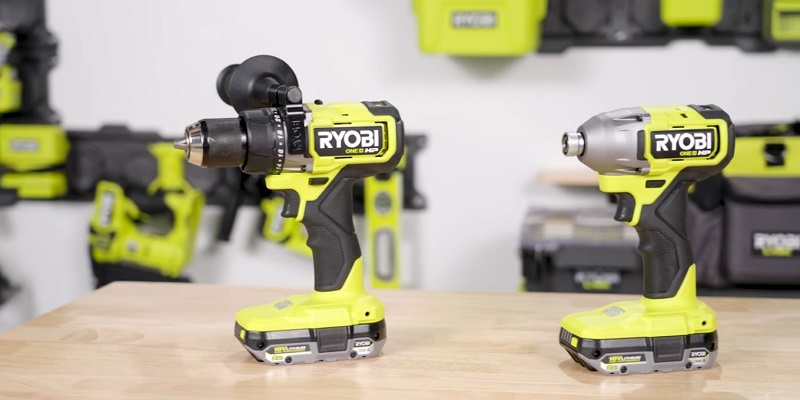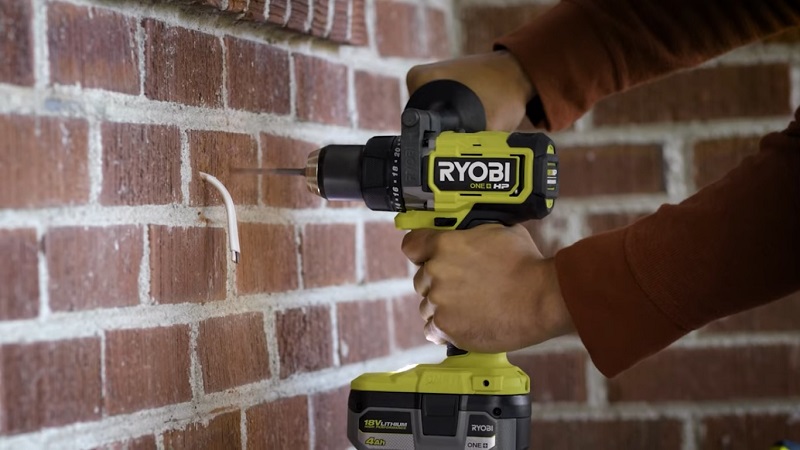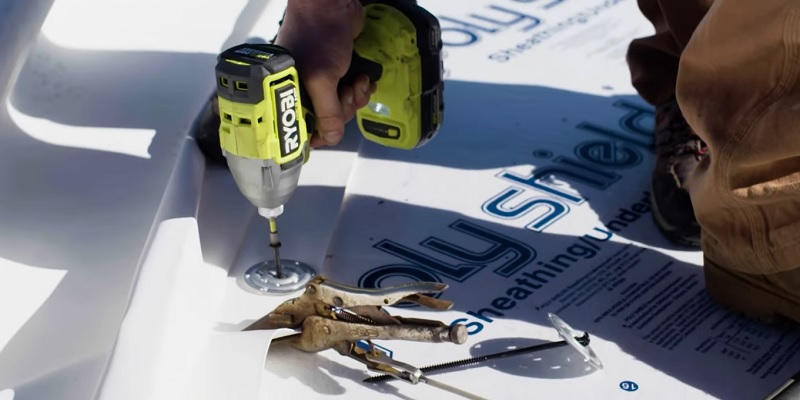If you’re into DIY or work as a contractor, picking between a hammer drill and an impact driver is key. It can greatly affect your project’s success. With the right info, you can choose the tool that makes your work easier and more efficient.

Key Takeaways
- Understand the key differences between hammer drills and impact drivers to make an informed choice
- Discover the ideal applications for each tool, whether it’s masonry work, woodworking, or general home improvement
- Learn how to maximize the performance and versatility of your power tools for successful project outcomes
- Explore safety considerations and maintenance tips to ensure the longevity of your hammer drills and impact drivers
- Compare the cost and accessibility of these essential power tools to find the best fit for your needs and budget
Understanding the Difference Between Hammer Drills and Impact Drivers
Hammer drills and impact drivers are two power tools with different uses. Knowing how they work helps you pick the right one for your projects.
Design and Functionality
Hammer drills are great for drilling into hard materials like concrete and brick. They use a special mechanism to make quick hammering motions. This helps the drill bit go through tough surfaces easily.
Impact drivers, on the other hand, are perfect for driving screws and bolts. They use a unique way to make strong impacts. This lets them handle even the toughest fasteners.
Power Source: Corded vs. Cordless
Both hammer drills and impact drivers come in corded and cordless types. Corded tools keep working without needing to be charged. They’re good for long tasks. Cordless tools are easy to move around. They’re great for jobs in hard-to-reach places.
When picking between corded and cordless, think about your project and where you’ll work. Cordless tools are getting more popular because of better batteries and their convenience.
Hammer Drill vs Impact Driver: Which Tool is Right for Your Projects?
Choosing between a hammer drill and an impact driver is key for many projects. Each tool has its own strengths. Knowing these can help you pick the best one for your needs.
Hammer drills are great for drilling into hard materials like concrete. They use a hammering action to get through brick and concrete. Impact drivers, on the other hand, are best for driving screws and bolts into wood and metal.
| Application | Hammer Drill | Impact Driver |
|---|---|---|
| Masonry Drilling | Excellent | Limited |
| Driving Screws | Good | Excellent |
| Woodworking | Good | Excellent |
| Metal Drilling | Good | Good |
For projects with different materials, having both tools is smart. The hammer drill is good for masonry. The impact driver is better for driving screws and bolts.
Choosing between a hammer drill and an impact driver depends on your project. Knowing what each tool does best helps you pick the right one.
Here, we chose these three models:
- Most reliable corded hemmer drill- SKIL HD182001
- Best advanced and powerful- DEWALT DCD996P2 Cordless Hammer Drill Kit
- Best professional grade- DEWALT DCF845B Impact Driver
Exploring the Strengths of Hammer Drills

A hammer drill is the top choice for hard masonry jobs. It’s made to drill through tough stuff like concrete, brick, and stone. This makes it a must-have for DIYers and pros alike.
Masonry Drilling: A Hammer Drill’s Forte
A hammer drill stands out because it can hammer and rotate at the same time. This combo lets it easily go through masonry. It’s perfect for concrete walls, stone bases, or brick buildings.
Compared to an impact driver, a hammer drill is better for big holes in masonry. Its hammering power makes clean, precise holes in hard materials. It’s key for tasks like installing anchors or making holes for wiring or plumbing.
When to Use a Hammer Drill
Hammer drills are great for masonry but not as good for wood. For wood, an impact driver or regular drill works better.
But, a hammer drill is useful for woodworking on hardwood or for big holes. Just be careful not to splinter the wood too much. Use the right drill bit for safety.
Impact Drivers: The Powerhouse for Driving Screws

Impact drivers are great for driving screws, bolts, and fasteners into different materials. They are small but very powerful. They use a special way to move fast, making it easy to secure fasteners without too much effort.
Impact drivers are not like hammer drills. Hammer drills are best for drilling into concrete and masonry. But impact drivers are made for driving and removing screws and bolts. They are perfect for many tasks, like putting together furniture or installing decking.
Impact drivers can handle big, hard fasteners easily. They have a lot of torque and move fast. This helps users drive tough screws and bolts without damaging them. This is why they are so useful for contractors and DIYers.
Also, impact drivers are easy to move around. They are small, so you can use them in tight spaces. This makes them a must-have for any toolbox, whether you’re working on a home project or a big construction site.
When to Use an Impact Driver
- Driving and removing screws, bolts, and other fasteners
- Assembling furniture, cabinetry, and other woodworking projects
- Installing decking, framing, and other construction tasks
- Securing heavy-duty hardware, such as hinges and brackets
- Tackling projects that require high-torque output and rapid impact action
Can an Impact Driver Be Used as a Hammer Drill?
Impact drivers are very versatile, but they can’t be used as hammer drills. They are made to give high-torque rotational blows. Hammer drills are better for drilling holes in masonry or concrete.
In short, impact drivers are the best for driving screws and bolts. They are fast, powerful, and easy to use. They are a key tool for any toolbox.
Comparing Performance: Hammer Drill vs Impact Driver
When choosing drilling tools, it’s key to look at the performance of hammer drills and impact drivers. Each tool has its own strengths. Knowing their speed and torque can help you pick the best one for your needs.
Speed and Torque Capabilities
Hammer drills are great for hard materials like concrete. They work at slower speeds, from 800 to 1,200 RPM. But, they can make a lot of torque, over 1,000 inch-pounds. This is perfect for tasks like making holes for anchors.
Impact drivers, on the other hand, are fast and strong. They can spin up to 3,000 RPM. This helps them quickly drive screws and bolts. They can also handle heavy tightening or loosening.
| Tool | Speed Range (RPM) | Torque Range (Inch-Pounds) |
|---|---|---|
| Hammer Drill | 800 – 1,200 | Over 1,000 |
| Impact Driver | Up to 3,000 | 1,500 – 2,000 |
Hammer drills and impact drivers are good for different jobs. Knowing their strengths helps you choose the right tool. This ensures your work is done well and efficiently.
Versatility: Can a Hammer Drill Replace an Impact Driver?
Hammer drills and impact drivers serve different purposes. Yet, they can sometimes swap roles. We’ll look into their versatility and if a hammer drill can be an impact driver, or vice versa, for some tasks.
A hammer drill is made for drilling into tough materials like concrete. It uses a pounding action. An impact driver, on the other hand, is for driving screws. It uses strong rotational force to fasten things quickly.
Can a hammer drill be used as an impact driver? Yes, but only a little. Some hammer drills have a “hammer only” mode for driving screws. But, it won’t do as well as a real impact driver. The hammer action can mess up the smooth screw driving.
Can an impact driver be used as a hammer drill? No. Impact drivers are not made for masonry drilling. Their design and power are not right for the hard pounding needed to drill into dense materials.
| Hammer Drill | Impact Driver |
|---|---|
| Designed for masonry drilling | Optimized for driving screws |
| Incorporates a pounding action | Delivers powerful rotational force |
| Limited effectiveness as an impact driver | Not well-suited for masonry drilling |
In short, a hammer drill can do some screw driving, but it’s not a good impact driver. An impact driver can’t replace a hammer drill for drilling into hard materials. It’s best to pick the right tool for the job to get the best results.
Safety Considerations When Using Hammer Drills and Impact Drivers
When using power tools like hammer drills and impact drivers, safety is key. These tools can be dangerous if not used carefully. It’s important to know the safety tips for each tool.
Hammer drills need extra care because they can kick back hard. This can make the tool jump out of your hands. To stay safe, hold the tool tight, use both hands, and drill straight down.
- Wear safety glasses, gloves, and ear protection.
- Make sure your work area is clear and you have good footing.
- Don’t push too hard, as this can cause kickback.
- Check the tool often and replace any worn parts.
Impact drivers are for screwing things in tight. They don’t kick back as much as hammer drills. But, you must use them carefully to avoid accidents.
- Make sure the workpiece is steady.
- Keep your fingers away from the bit.
- Don’t use impact drivers on soft materials or in tight spots.
- Check the tool’s accessories often.
Always put safety first when using hammer drills, impact drivers, or any power tool. Follow these tips to work safely and efficiently on your projects.
Hammer Drill vs Impact Driver: Which Tool Should You Buy?
Choosing between a hammer drill and an impact driver can be tough. You need to think about your home improvement projects. Each tool has special skills. The right choice depends on your needs and the tasks you have.
Factors to Consider
When picking between a hammer drill and an impact driver, think about these:
Project Requirements: Think about the materials and tasks you’ll face. Hammer drills are great for hard materials like concrete. Impact drivers work well for softer materials like wood.
Power and Performance: Look at the tools’ torque, speed, and power. Impact drivers have more torque for screws. Hammer drills have more force for hard materials.
Portability and Convenience: Consider the tool’s size, weight, and if it’s cordless. Cordless impact drivers are easy to move. Corded hammer drills give steady power for tough tasks.
Accessory Compatibility: Check the tools’ accessories like drill bits and screw tips. This shows which tool is more versatile for you.
By thinking about these points, you can pick the best power tool for your projects. It could be a hammer drill or an impact driver.
Accessories and Attachments for Hammer Drills and Impact Drivers
Adding accessories and attachments to your power tools can really help. They make your hammer drill and impact driver work better. This lets you do more tasks easily and well.
Drill bit sets are key for hammer drills. They come in many sizes and materials. This lets you drill small holes or big masonry jobs. You can also get special bits for tile or metal.
Impact drivers need a set of driver bits. These include Phillips, flat, and Torx bits for different screws. The bits are made to handle the tool’s high torque, so they fit securely.
Versatile Attachments for Hammer Drills and Impact Drivers
- Drill Stands: These turn your handheld tool into a stationary one. This is great for precise work like installing cabinets.
- Angle Attachments: These let you reach tight spots or odd angles. They’re perfect for tasks like cabinet hinges.
- Extension Rods: These rods let you drill from a distance. They’re great for reaching high places or hard spots.
- Dust Extraction Accessories: These keep your area clean by catching dust. They’re useful when drilling or screwing messy materials.
Getting the right accessories boosts your tool’s power and your work. Knowing what these tools can do helps you do more projects. You’ll feel more confident in your DIY and professional work.
| Accessory | Hammer Drill | Impact Driver |
|---|---|---|
| Drill Bits | ✓ | – |
| Driver Bits | – | ✓ |
| Drill Stands | ✓ | ✓ |
| Angle Attachments | ✓ | ✓ |
| Extension Rods | ✓ | ✓ |
| Dust Extraction | ✓ | ✓ |
Maintenance and Care Tips for Prolonged Tool Life
Keeping your hammer drills and impact drivers in good shape is key. Simple steps can make them last longer and work better. This way, you get the best value from your tools.
Keep Them Clean
Cleaning your tools regularly is a must. Use a soft cloth or brush to wipe off dirt and dust. This stops them from getting too hot and keeps air moving, helping your tools last longer.
Lubricate Moving Parts
Put a few drops of oil on the moving parts, like the chuck and gears. This cuts down on friction and wear. Always check the maker’s advice on oil type and how often to use it.
Store Properly
Put your tools away in a dry, clean, and airy spot when you’re not using them. Don’t let them get too hot, wet, or sunny. These conditions can harm your tools and shorten their life.
Replace Worn Parts
- Check your tools often for worn-out parts, like brushes, chucks, or bearings.
- Fix these parts right away to keep your tools safe and working well.
- Use genuine parts from the maker for the best fit and quality.
By taking care of your tools, you can make them last longer. They’ll keep working great for all your projects.
Cost Comparison: Hammer Drills vs Impact Drivers
When picking between a hammer drill and an impact driver, cost matters a lot. Prices change based on brand, features, and if it’s corded or cordless. We’ll look at typical costs to help you choose within your budget.
Hammer drills are usually cheaper, costing between $50 for simple ones and $200 for top models. The price depends on power, speed, and extra features like variable speed and adjustable clutch.
Impact drivers, on the other hand, cost more, from $80 to $300. They’re pricier because they’re made for high torque and power, perfect for driving screws and fasteners.
| Tool | Average Cost Range | Key Factors Affecting Cost |
|---|---|---|
| Hammer Drill | $50 – $200+ | Power, speed, features (variable speed, adjustable clutch) |
| Impact Driver | $80 – $300+ | Torque, power, brand, cordless vs. corded |
Cordless power tools, like battery-powered hammer drills and impact drivers, cost more. But, their convenience and mobility might be worth the extra money for many.
When comparing costs, think about your project needs, budget, and how often you’ll use the tool. Look at each tool’s features and performance to make the right choice for your drilling and fastening tasks.
Final Words
Choosing between a hammer drill and an impact driver depends on your project’s needs. Each tool has its own strengths and uses. This helps us pick the right tool for masonry, woodworking, or home improvement.
This guide has given us the tools to choose the right power tool. We can decide based on the tool’s drilling or driving power. Now, we know what to look for when picking between these tools.
We’ve used keywords like “hammer drill vs impact driver” and “which tool is right for you?” to make the content better. This way, we can find the perfect tool for our next project.
FAQ
What is the difference between a hammer drill and an impact driver?
Hammer drills are for drilling into hard stuff like concrete and brick. They pound and rotate to make holes. Impact drivers are for driving screws and bolts fast. They use high-torque impacts to do this.
When should I use a hammer drill versus an impact driver?
Use a hammer drill for hard materials like concrete. The drill’s pounding helps it get through. Use an impact driver for screws and bolts. Its high-torque impacts make it quick and easy.
Can I use a hammer drill as an impact driver?
Hammer drills and impact drivers are not the same. A hammer drill can’t drive screws as well as an impact driver. An impact driver can’t drill into hard materials like a hammer drill.
Is it okay to use a hammer drill on wood?
You can use a hammer drill on wood, but it’s not the best choice. The drill’s pounding can splinter wood. For wood, use a regular power drill or an impact driver for better results.
Can an impact driver be used as a hammer drill?
No, an impact driver is not a hammer drill substitute. Impact drivers are for fasteners, not for drilling into hard materials. Using an impact driver for drilling can damage it.
What are the speed and torque capabilities of hammer drills versus impact drivers?
Hammer drills have higher speeds for drilling hard materials. Impact drivers have more torque for driving fasteners. This makes them good for stubborn fasteners.
What safety considerations should I keep in mind when using a hammer drill or impact driver?
Always wear safety gear like glasses and gloves when using these tools. Hold the tool right and keep your balance. Follow the tool’s safety rules to avoid accidents.


